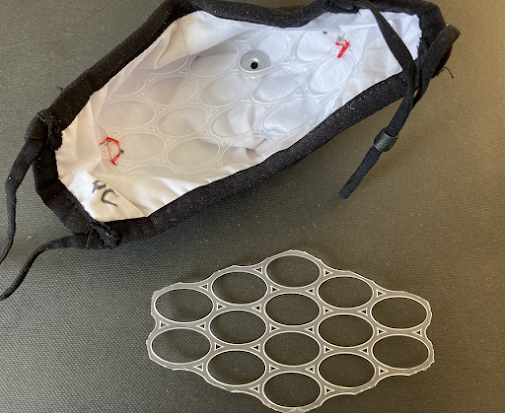Supield brand nano-fabric mask that's washable
There's a bunch of vendors online that sell this inexpensive mask. Here it is on AliExpress. The key particle filtration is is achieved by a new nano fabric in two layers and placed between a woven cotton outer and a woven liner of some sort. Snip snip:
It's claimed to have 95% particle filtration efficiency, and that it will retain good filtration through careful cleaning protocols.
The masks come shipped with a nose wire made from "memory plastic" which is truly terrible. For my high nose-bridge face, this one thing drops the filtration efficiency down to 80% out of box so to speak. If I snip the cotton trim that holds the wire on the inside of the mask, I can pull out the plastic. I can then push in a replacement wire that is far more satisfactory and allows the mask to perform up to the levels promised.
Placing one though the regular washing machine then tumble dryer three times saw it's PFE plummet to 73%. The manufacturer never said it would perform well through the washing machine. Reminder: I'm using a PortaCount 8020A made in 1998 for PFE testing.
Four similar hot-water immersion protocols:
- 1 min immersion in boiled water, then drip & air dry
- 1 min immersion in boiled water with Johnsons Baby Shampoo, then drip & air dry
- 1 min immersion in hand-hot water with Johnsons Baby Shampoo, then drip & air dry
- 1 min immersion in hand-hot water with liquid hand soap, then drip & air dry
Filtration loss trending down. Admittedly my results are up and down. Rounds 0 to 3 were with ambient air. Round 4 & 5 were with NaCl pumped into an enclosed space using an ultrasonic humidifier (5% solution of Morton salt with distilled water).
Immersion of a mask in 99.9% Isopropyl Alcohol (IPA) then drip & air dry works well. That's expensive though and not particularly environmentally friendly if scaled up.
Placing a mask in a pressure cooker is pretty good and sustainable. That's a temp of 116 °C or so. The mask in this test also had a sewn-in plastic brace to aid breathability - it reduces the collapse of the mask onto the wearer's face that happens with each breath in. Sewn in by me. When brand new, the mask holds is shape well enough, but each cleaning increased the fabric loses a bit more of its structural integrity. Lastly, if you sneeze on the inside of the mask - or get coffee stains on it, the pressure cooker regime isn't going to clean that off.
In the end, I think the nano fabric doesn't stand up to repeat manipulation. Prescientx in Canada makes an elastomeric mask that utilizes a similar nano fabric - https://prescientx.com/[breathe] - and the frame for that will hold the fabric in such a way that it will not flex for breaths in or out.
If the world wants a cloth style masks that is repeatably washable it will have to keep looking. I've many more of these, so I might run more tests despite the disappointment.
The makers of this mask, or other companies looking for carry on in this direction:
- Use a 11 cm nose-wire that is thicker than the classic 8.5 cm stamped aluminum.
- The liner should incorporate some nylon lattice to give the mask some stiffness.
- Publish washing protocols that don't overly flex the nano-fabric
- Give up on designing a product that can be folded for sale or transport.
Update (July 8): The nylon lattice I talk of
Boning is a product you can but for sewing wedding veils or fancy hats. Here is some I got from Amazon: https://www.amazon.co.uk/gp/product/B01C688QGI . I have sewn some in and retested:
Two lengths of boning sewn together to make them stiffer.
I've also treated the ends with a naked flame in an unsuccessful attempt
to make it less sharp as I don't want to tear the nano-fabric feeding
it in. I snipped open the liner at one side of the mask and threaded that piece in. If it wasn't clear, this piece is inside the woven liner, and the two layers of nano material are held further out from your face by this flexible lattice.
Result set 1:
Run 1: 94.9416%, ave so far: 94.9416%
Run 2: 98.3469%, ave so far: 97.1754%
Run 3: 98.5805%, ave so far: 97.7408%
Run 4: 98.6056%, ave so far: 98.0232%
Run 5: 98.3461%, ave so far: 98.1072%
Run 6: 98.7850%, ave so far: 98.2405%
Run 7: 97.8035%, ave so far: 98.1782%
Run 8: 98.3172%, ave so far: 98.1943%
Overall Average: 98.1943%
High: 98.7850%
Low: 94.9416%
The inner fabric still partially hits your lips as you breath in. Not perfect. Some people would hate that. Lipstick wearers perhaps. So I sewed one more line horizontally through the mask holding the boning to the fabric, and away from your lips. Much better:
Run 1: 98.9817%, ave so far: 98.9817%
Run 2: 98.9127%, ave so far: 98.9485%
Run 3: 98.9389%, ave so far: 98.9454%
Run 4: 99.0851%, ave so far: 98.9810%
Run 5: 99.1131%, ave so far: 99.0064%
Run 6: 99.1365%, ave so far: 99.0272%
Run 7: 99.1261%, ave so far: 99.0408%
Run 8: 99.1613%, ave so far: 99.0551%
Overall Average: 99.0551%
High: 99.1613%
Low: 98.9127%
Better filtration but that could be chance. Greater surface area through which air is sucked will always mean better filtration, but sometimes that may not be easy to detect. Probably better breathability with this modification. This is a much better than the hexagonated brace shown a few days ago. There is no way I'd put this mask though a washing machine, as it wouldn't emerge with it's shape intact.
This mask (marked Z) has not been cleaned yet. That's up next.
Note re "Boning": Gail Kollmar was using such materials at the start of the pandemic - https://www.youtube.com/watch?v=fhGqD4V0NDA






Comments
Post a Comment